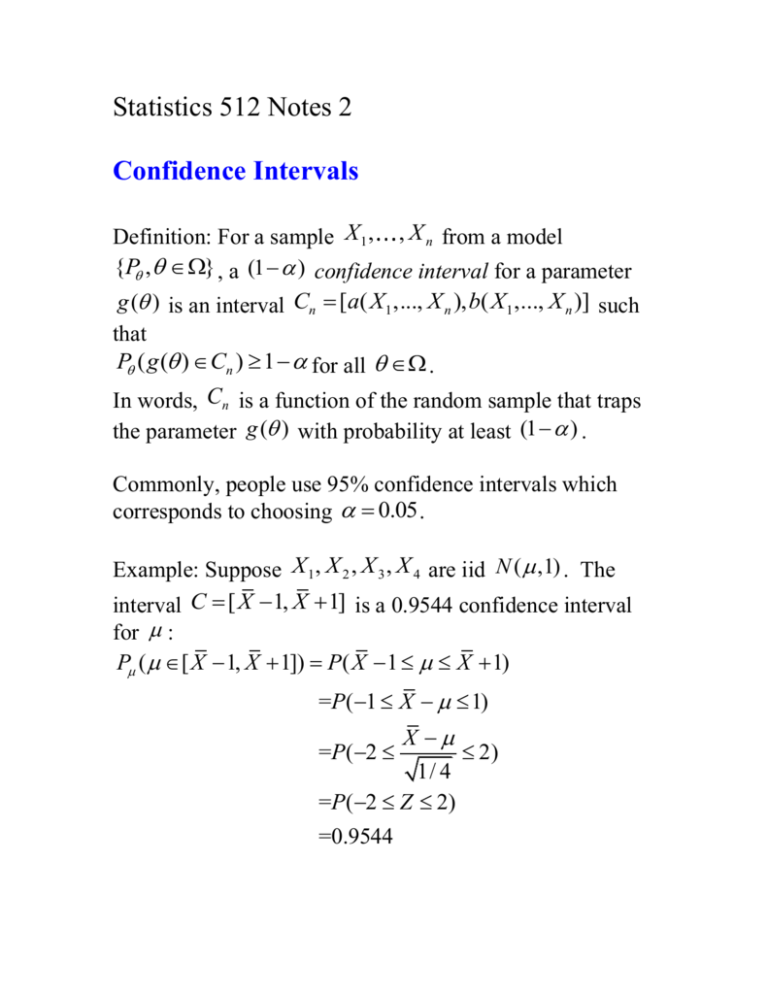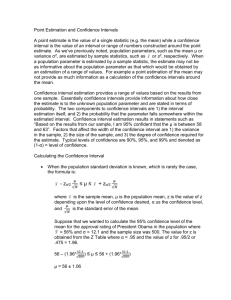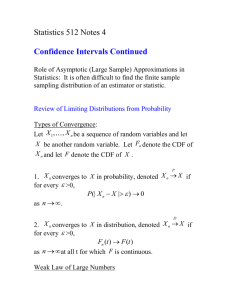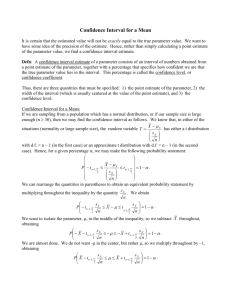Notes 3 - Wharton Statistics Department
advertisement

Statistics 512 Notes 2
Confidence Intervals
Definition: For a sample X 1 , , X n from a model
{P , } , a (1 ) confidence interval for a parameter
g ( ) is an interval Cn [a( X1 ,..., X n ), b( X1 ,..., X n )] such
that
P ( g ( ) Cn ) 1 for all .
In words, Cn is a function of the random sample that traps
the parameter g ( ) with probability at least (1 ) .
Commonly, people use 95% confidence intervals which
corresponds to choosing 0.05 .
Example: Suppose X1 , X 2 , X 3 , X 4 are iid N ( ,1) . The
interval C [ X 1, X 1] is a 0.9544 confidence interval
for :
P ( [ X 1, X 1]) P( X 1 X 1)
=P( 1 X 1)
X
2)
1/ 4
=P( 2 Z 2)
=0.9544
=P( 2
Motivation for confidence intervals:
A confidence interval can be thought of as an estimate of
the parameter, i.e., we estimate by [ X 1, X 1] rather
than the point estimate X .
What is gained by the using interval rather than the point
estimate since the interval is less precise?
We gain confidence. We have the assurance that in 95.44%
of repeated samples, the confidence interval will contain
.
In practice, confidence intervals are usually used along
with point estimates to give a sense of the accuracy of the
point estimate.
Interpretation of confidence intervals
A confidence interval is not a probability statement about
g ( ) since is a fixed parameter, not a random variable.
Common textbook interpretation: If we repeat the
experiment over and over, a 95% confidence interval will
contain the parameter 95% of the time. This is correct but
not particularly useful since we rarely repeat the same
experiment over and over.
More useful interpretation (Wasserman, All of Statistics) :
On day 1, you collect data and construct a 95 percent
confidence interval for a parameter 1 . On day 2, you
collect new data and construct a 95 percent confidence
interval for an unrelated parameter 2 . On day 3, you
collect new data and construct a 95 percent confidence
interval for an unrelated parameter 3 . You continue this
way constructing 95 percent confidence intervals for a
sequence of unrelated parameters 1 , 2 ,
Then 95
percent of your intervals will trap the true parameter value.
Confidence interval is not a probability statement about :
The fact that a confidence interval is not a probability
statement about is confusing. Let be a fixed, known
real number and let X1 , X 2 be iid random variables such
that P( X i 1) P( X i 1) 1/ 2 . Now define
Yi X i and suppose we only observe Y1 , Y2 . Define the
following “confidence interval” which actually contains
only one point:
{Y1 1} if Y1 Y2
C
{(Y1 Y2 ) / 2} if Y1 Y2
No matter what is, we have P ( C ) 3/ 4 so this is a
75 percent confidence interval. Suppose we now do the
experiment and we get Y1 15 and Y2 17 . Then our 75
percent confidence interval is {16}. However, we are
certain that is 16.
Some common confidence intervals
1. CI for mean of normal distribution with known variance:
X 1 , , X n iid N ( , 2 ) where 2 known.
X
Then
~ N (0,1)
n
1
Let z ( ) where is the CDF of a standard normal
random variable, e.g., z.975 1.96 . We have
X
1 P z
z
1
1
2
2
n
P z
X z
X
1
n
2
1 2 n
P X z
X z
1
1
n
n
2
2
Thus, X z1
2
(1 ) CI for
n is a
2. CI for mean of normal distribution with unknown
variance.
X 1 , , X n iid N ( , 2 ) where 2 unknown.
X
T
S
Key fact: The random variable
, where
n
1
n
2
S2
(
X
X
)
i
, has a Student’s t-distribution
n 1 i 1
with n-1 degrees of freedom. (Section 3.6.3, page 186)
Let t ,n be the inverse of the CDF of the Student’s tdistribution with n degrees of freedomevaluated at .
Note t t1
Following the same steps as above, we have
X
1 P t
t
1 , n
2
1 2 ,n S
n
S
S
P t
X t
X
1 , n
n
2
1 2 ,n n
S
S
P X t
X t
1 , n
1 , n
n
n
2
2
S
X
t
(1 ) CI for
Thus,
1 , n
n is a
2
Note: t1 ,n z1 so we pay a price for not knowing the
2
2
variance but as n , t1 ,n z1 .
2
2
3. CI for mean of iid sample from unknown distribution:
Central Limit Theorem (Theorem 4.4.1): For an iid sample
from a distribution that has mean and positive variance
X
Yn n
2
, the random variable
converges in
n
distribution to a standard normal random variable.
Slutsky’s Theorem (Theorem 4.3.5):
D
P
P
D
X n X , An a, Bn b, then An Bn X n a bX .
4
From the weak law of large numbers, if E ( X )
P
1
n
2
2
2
S
(
X
X
)
i
.
n 1 i 1
Thus, combining Slutsky’s Theorem and the central limit
theorem,
Xn D
N (0,1)
S
n
S
X
z
An approximate (1 ) CI for is n 1 / 2 n because
X
1 P z
z
1
S
2
1 2
n
S
S
P z
X z
X
1
n
2
1 2 n
S
S
P X z
X z
1
1
n
n
2
2
Application: A food-processing company is considering
marketing a new spice mix for Creole and Cajun cooking.
They interview 200 consumers and find that 37 would
purchase such a product. Find an approximate 95%
confidence interval for p, the true proportion of buyers.






![The Average rate of change of a function over an interval [a,b]](http://s3.studylib.net/store/data/005847252_1-7192c992341161b16cb22365719c0b30-300x300.png)


